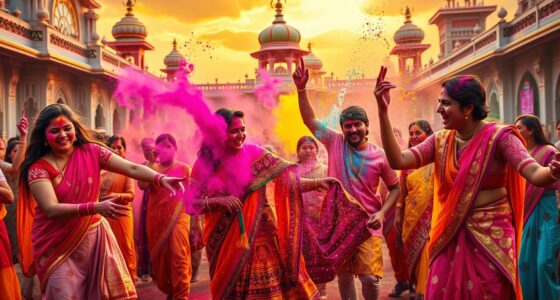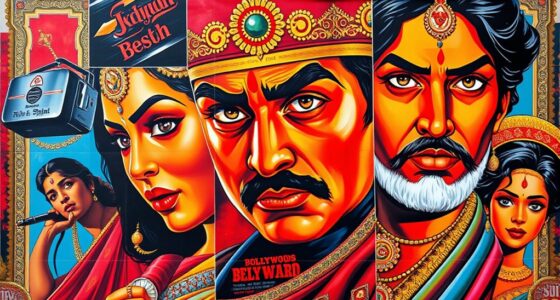Background scores shape the emotional tone of a movie, guiding your feelings without you noticing. They use recurring motifs as sonic signatures for characters or themes, deepening your connection and heightening key moments. Music signals danger, hope, or victory, helping you understand complex emotions effortlessly. These layered soundscapes make scenes more intense and memorable, acting as an invisible character that amplifies the story. Keep exploring to discover how these subtle cues leave a lasting impact on your cinematic experience.
Key Takeaways
- Iconic background scores create emotional resonance, making movies more memorable and impactful for viewers.
- Musical motifs serve as sonic signatures, deepening connection to characters and themes.
- Scores evoke specific emotions like suspense, hope, or dread, guiding audience reactions subconsciously.
- Layered and evolving music enhances storytelling, adding depth and complexity to scenes.
- Seamless integration of scores amplifies empathy and leaves a lasting emotional impression.

Background scores play a essential role in shaping the emotional tone of a movie, often influencing how you experience a scene without you even realizing it. When you watch a film, the music isn’t just background noise; it’s a carefully crafted tool that guides your feelings and reactions. One of the most powerful techniques in film scoring involves the use of musical motifs—recurring melodies or themes associated with specific characters, ideas, or emotions. These motifs act like sonic fingerprints, subtly reminding you of a character’s presence or an underlying theme, even when they’re not on screen. Over time, these motifs develop emotional resonance, deepening your connection to the story and characters. When a villain’s dark, foreboding motif returns, it heightens your sense of danger or dread. Conversely, a triumphant, soaring melody might signal hope or victory, evoking a sense of uplift. These musical cues become ingrained in your subconscious, reinforcing the narrative’s emotional landscape without overpowering the visuals.
The beauty of musical motifs lies in their ability to create a layered storytelling experience. They serve as emotional shorthand, quickly conveying complex feelings or ideas that might take several minutes of dialogue or action to express. As the film progresses, motifs evolve, gaining emotional resonance that aligns with the characters’ growth or shifting story arcs. This evolution allows you to feel more deeply immersed in the story, almost as if the music is speaking directly to your emotions. For example, a gentle, tender motif might underscore a budding romance, growing richer and more complex as love blossoms. Or a tense, dissonant motif can heighten suspense in a thriller, making your heartbeat quicken as danger approaches. These musical markers help you intuitively grasp what’s happening beneath the surface, creating a more visceral, memorable experience.
Ultimately, the most memorable background scores are those that seamlessly blend music and emotion, using motifs and their emotional resonance to enhance storytelling. They don’t just fill silence; they amplify understanding and empathy, making scenes more impactful. When you think back on your favorite movies, it’s often the music—those subtle, recurring motifs—that lingers in your mind, shaping your emotional response long after the credits roll. In this way, a well-crafted score becomes an invisible but influential character in the film, guiding your feelings and enriching your overall cinematic journey.
Frequently Asked Questions
How Do Composers Choose Themes for Movie Scores?
You choose themes for movie scores by identifying key moments and emotions, then craft musical motifs that reflect those feelings. Composers focus on creating memorable motifs that can be developed thematically throughout the film, enhancing character arcs and plot points. They use thematic development to evolve these motifs, ensuring the score deepens the story’s impact and resonates emotionally with viewers, making the overall experience more immersive and memorable.
What Is the Process of Recording a Film Score?
You start by translating the director’s vision into your film scoring techniques, then collaborate with musicians to create orchestral arrangements. You record the score in a studio, often syncing it precisely with the film’s timing. You might use digital tools for editing and mixing, ensuring the music complements the scenes perfectly. The process demands attention to detail, blending creativity with technical skill to craft memorable cinematic moments.
How Do Background Scores Influence Audience Emotions?
You feel more connected to a scene when the background score uses musical motifs and emotional resonance. These elements subtly guide your emotions, heightening suspense, joy, or sadness. The music amplifies the mood, making you empathize with characters and storylines. By carefully crafting these scores, filmmakers influence your emotional journey, ensuring you experience the narrative on a deeper level and remember the movie long after it ends.
Who Are Some Legendary Composers Behind Iconic Scores?
You should know that legendary composers like John Williams, Hans Zimmer, and Ennio Morricone have crafted iconic scores that use music symbolism to deepen storytelling. Their composer collaborations bring unique emotional layers, making scenes unforgettable. Williams’s soaring themes, Zimmer’s innovative sounds, and Morricone’s passionate melodies have shaped cinematic history. Their work highlights how masterful composition elevates movies, resonating with audiences long after the credits roll.
How Has Technology Changed Film Scoring Over the Years?
Technology transforms your film experience by making scoring more seamless and sophisticated. Digital sampling allows composers to craft complex sounds quickly, while an orchestral revival blends traditional instruments with modern techniques. You’ll notice richer, more immersive soundscapes, creating cinematic symphonies that resonate deeply. This technological transformation empowers composers to experiment, elevating your emotional engagement and making each movie moment more memorable through innovative, inspiring sound design.
Conclusion
So, next time you find yourself humming a movie tune, remember—those background scores, often unnoticed, are secretly shaping your favorite memories. Ironically, it’s the music you don’t notice that makes the scenes unforgettable. Without them, your favorite movies might just feel empty, like a cake without frosting. So, give a nod to those silent heroes behind the scenes—they’re the real stars, even if they never get a standing ovation.







